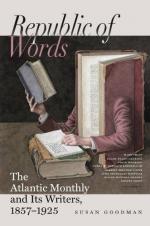[Footnote F: Memoires de la Societe Ethnologique, Tom. I. Ptie 2, p. 147.]
D’Eichthal develops at great length his theory, that the Foulahs are descended from some Eastern people of strong Malay characters, who found their way to their present site through Madagascar, along the coast, to Cordofan, Darfour, and Haoussa. They are bronzed, or copper-colored, or like polished mahogany,—the red predominating over the black. Their forms are tall and slim, with small hands and feet, thin curved noses, long hair braided into several queues, and an erect profile. Certain negro traits do not exist in them.
Burmeister, who saw Ira Aldridge, the Foulah actor, play in Macbeth, Othello, and his other famous parts, saw nothing negro about him, except the length of his arm, the shrillness of his voice in excitement, the terrible animality of the murder-scenes, and his tendency to exaggerate. “The bright-colored nails were very evident, and his whole physiognomy, in spite of his beard, was completely negro-like."[G]
[Footnote G: The Comparative Anatomy and Physiology of the African Negro, by Hermann Burmeister.]
But if Ira Aldridge’s exaggerated style of acting points to an African origin, would it not be better, if some of our distinguished actors, who are presumptively white before the foot-lights, took out free-papers at once? We have seen Macbeth and Othello so “created” by the Caucasian models of the stage, that but one line of Shakspeare remained in our memory, and narrowly escaped the lips,—“Out, hyperbolical fiend!”
It is not unlikely that the Felatah was mixed with Moorish or Kabylic blood to make the Foulah. If so, it proves the important fact, that, when the good qualities of the negro are crossed with a more advanced race, the product will be marked with intelligence, mobility, spiritual traits, and an organizing capacity. Felatah blood has mixed with white blood in the Antilles; the Jolof and the Eboe have yielded primitive affections and excellences to a new mulatto breed. This great question of the civilizable qualities of a race cannot be decided by quoting famous isolated cases belonging to pure breeds, but only by observing and comparing the average quality of the pure or mixed.
When we approach the Slave Coast itself, strong contrasts in appearance and culture are observable among the inhabitants; they are all negroes, but in different social conditions, more or less liable to injury from the presence of the slaver, and yielding different temperaments and qualities to colonial life. The beautiful and fertile amphitheatre called Whidah, in North latitude 6 deg., with Dahomey just behind it, is populous with a superior race. Where did it come from? The area which it occupies has only about fifty miles of coast and less than thirty of interior; its people are as industrious and thrifty as any on the face of the earth. They never raised sugar and indigo with enthusiasm, but at home their activity would have interpreted to Mr. Carlyle a soul above pumpkins. They cultivated every square foot of ground up to the threshold of their dwellings; the sides of ditches, hedges, and inclosures were planted with melons and vegetables, and the roads between the villages shrank to foot-paths in the effort to save land for planting. On the day when a crop was harvested, another was sown.




